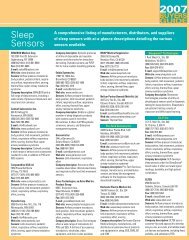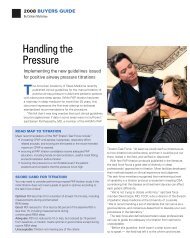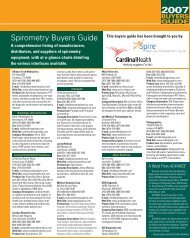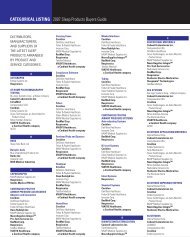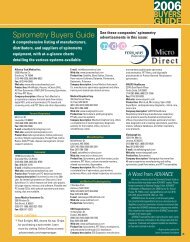View Full Screen - ADVANCE for Respiratory Care and Sleep ...
View Full Screen - ADVANCE for Respiratory Care and Sleep ...
View Full Screen - ADVANCE for Respiratory Care and Sleep ...
Create successful ePaper yourself
Turn your PDF publications into a flip-book with our unique Google optimized e-Paper software.
n CHRONIC OBSTRUCTIVE PULMONARY DISEASE<br />
CALLING<br />
ALL<br />
STUDENTS!<br />
IT’S A CONTEST<br />
JUST FOR YOU.<br />
<strong>ADVANCE</strong> is proud to announce<br />
the Faces of the Future:<br />
National Student Writing Contest,<br />
which will highlight the field’s new<br />
class of thought leaders.<br />
WIN<br />
$250!<br />
Gain recognition in the<br />
field <strong>and</strong> plump up your<br />
resume. One first place<br />
article will win a $250<br />
cash prize <strong>and</strong> be<br />
published online in August.<br />
might be different between the races.”<br />
Does the evidence hold up<br />
Gerard J. Criner, MD, serves as Philadelphia<br />
clinical center director <strong>for</strong> the National Institute<br />
of Health’s massive COPDGene study. The<br />
underlying purpose of the study, Dr. Criner said,<br />
is to discover if there are independent genetic<br />
factors that can explain racial <strong>and</strong> gender differences<br />
in susceptibility to smoking <strong>and</strong> COPD.<br />
“We’re identifying different patterns found on<br />
X-ray — more airway disease, more emphysema,<br />
more airways obstruction — things that no one<br />
could articulate be<strong>for</strong>e, without study in<strong>for</strong>mation,”<br />
Dr. Criner said. “We may discover separate<br />
clinical phenotypes found in COPD patients<br />
that have some relationship to race.”<br />
While variables of susceptibility may exist,<br />
Dr. Criner emphasized that in more than 10,000<br />
COPD patients involved in the study there is a<br />
substantial amount of genetic mixture that has<br />
occurred over the generations. “So, there may<br />
be more variability than can be explained by<br />
gender or race,” he said. “But we won't know<br />
<strong>for</strong> sure until data has been analyzed. We need<br />
to use caution. It still remains to be seen.”<br />
But Dr. Dransfield drew a line in the genetic<br />
susceptibility debate, noting there are most certainly<br />
differences between the races. “It’s a touchy<br />
subject, but there clearly are,” he said. “It’s not all<br />
about access of care <strong>and</strong> quality of care, as some<br />
might suggest. That’s another issue that is valid.<br />
But there is still more. Just as there are differences<br />
between men <strong>and</strong> women that have to do<br />
with hormones, so are there differences between<br />
the races in a variety of gene frequencies. There<br />
could be lots of differences, including nicotine<br />
metabolism, how well the body deals with oxygen<br />
stress, or how aggressively the neutrophils in the<br />
body respond to the stimulus from cigarette<br />
smoke. We are not all exactly the same.”<br />
And both men agreed that genetic factors,<br />
working in concert with environmental factors<br />
— such as an urban or rural atmosphere, or<br />
exposure to certain pollutants or chemical substances<br />
— could point toward heightened COPD<br />
susceptibility.<br />
Why does it matter<br />
“Biological Environmental Physiological I<br />
don’t know. It could be all of them, none of them,<br />
or a combination,” said a reflective Dr. Criner,<br />
who is also a professor, chief of pulmonary <strong>and</strong><br />
critical care medicine, <strong>and</strong> director of the intensive<br />
care unit <strong>and</strong> ventilator rehabilitation unit<br />
at Temple University Hospital, Philadelphia.<br />
But he stated with certainty that when it comes<br />
to patient care, defining the susceptibility variables<br />
will have l<strong>and</strong>mark effects. Once it is established<br />
that there are distinct presentations of this disease<br />
predicted by certain characteristics of gender or<br />
race, patients will be followed earlier, more carefully,<br />
<strong>and</strong> their outcomes may be different.<br />
“If we can identify certain proteins or genes<br />
or combinations that could indicate a different<br />
prognosis or even identify potential targets <strong>for</strong><br />
treatment, that will have significant impact on<br />
improved practice,” Dr. Criner said. “And it will<br />
certainly give more credence to the notion of<br />
personalized health care. We can’t treat everybody<br />
the same.” n<br />
Contact Valerie Neff Newitt at vnewitt<br />
@advanceweb.com<br />
ENTER ONLINE<br />
Visit www.advanceweb.com/respiratory<br />
<strong>and</strong> click on “Faces of the Future” icon to<br />
submit your 1,400 word article.<br />
ENTRY DEADLINE:<br />
JUNE 20, 2011<br />
QUESTIONS<br />
Contact Kristen Ziegler at<br />
800-355-5627, ext. 1803,<br />
or kziegler@advanceweb.com<br />
Ask the Expert<br />
Q: I am considering using one-way valves to prevent cross contaminations<br />
in my spirometry testing. Is this the best method<br />
A: One-way valves can be a potential cost-saving consumable that prevent inhalation through<br />
a reusable sensor <strong>for</strong> hygiene purposes. However, in terms of diagnostic spirometry, the<br />
inspiration following the <strong>for</strong>ced expiration is key in<strong>for</strong>mation to assess patient compliance.<br />
Compared to a one-way valve, a disposable turbine that is singularly packed <strong>and</strong> factorycalibrated<br />
guarantees hygiene <strong>and</strong> cost-effectiveness, along with the advantage of adding<br />
full-featured diagnostic capabilities of a complete flow/volume loop as recommended by the<br />
American Thoracic Society.<br />
—Donald Melnikoff, president, MIR Medical International Research USA<br />
20 <strong>ADVANCE</strong> <strong>for</strong> Healthcare <strong>Care</strong>ers



